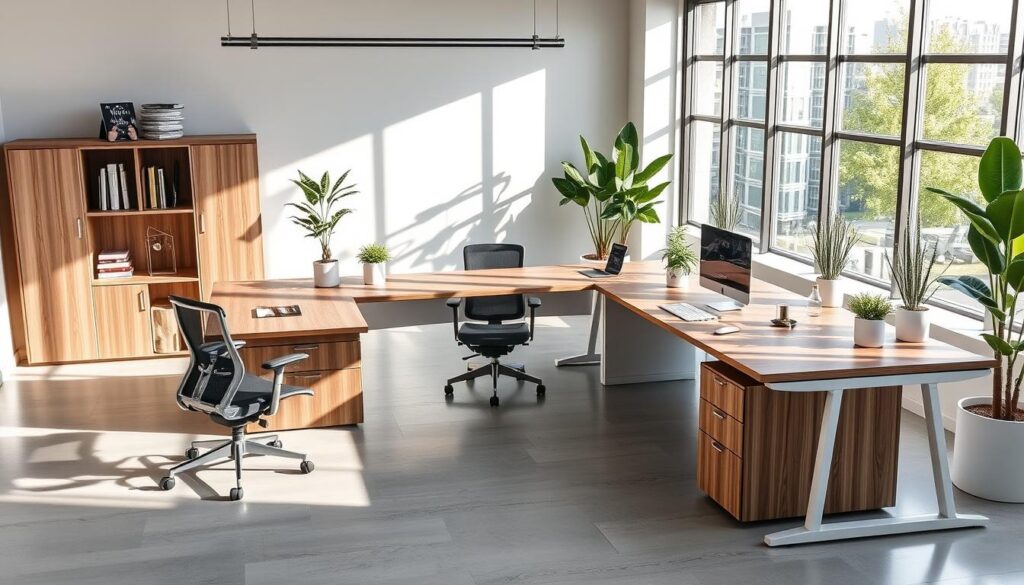
An l shaped desk with a 30′ counter maximizes corner space and boosts productivity. This design offers a practical and stylish way to revamp your office area. These expert tips will help you create an efficient L-shaped desk setup.
The L-shaped configuration helps you use every inch of available room. With a 30′ counter, you’ll have plenty of space for your computer and paperwork. This extended length offers flexibility for various workspace layouts.
When planning your l shaped desk, think about adding storage solutions like drawers. This will keep your workspace organized and clutter-free. A good mix of form and function will boost your productivity.
Key Takeaways
- L-shaped desks maximize corner space utilization
- 30′ counters provide ample room for work essentials
- Proper design enhances productivity and organization
- Consider storage solutions for a clutter-free workspace
- L-shaped configurations offer flexibility in layout options
Understanding the Basics of L-Shaped Desk Design
L-shaped desks maximize workspace in offices and homes. They offer unique benefits for organization and efficiency. Let’s explore key aspects of L-shaped desk design.
Key Measurements and Dimensions
L-shaped desks consist of two perpendicular surfaces. The standard desk height is 29-30 inches. Consider your available space and needs for side lengths.
A common setup might have one side at 60 inches and the other at 48 inches. Carefully plan your desk dimensions for the best fit.
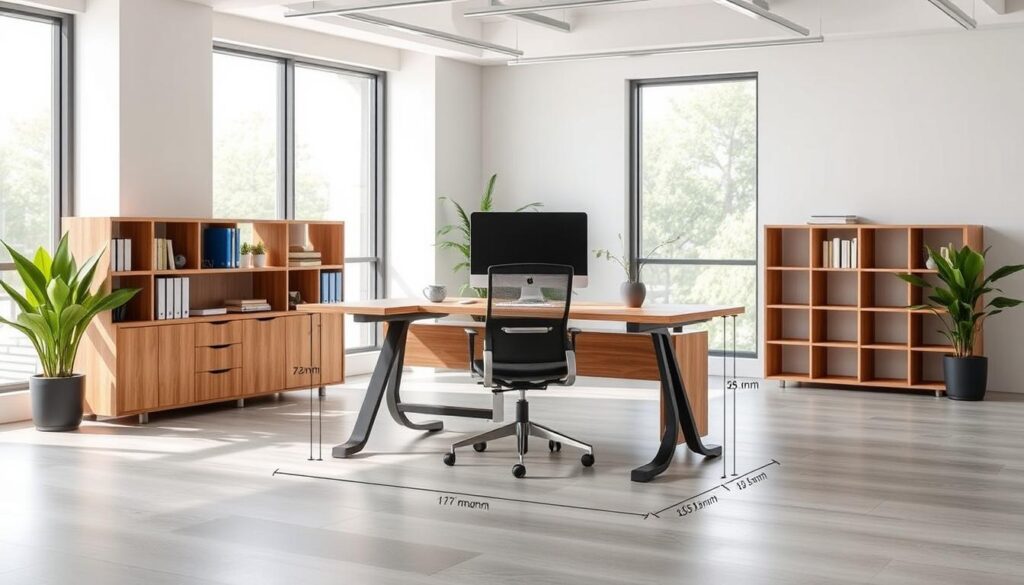
Optimal Room Placement
Room layout affects your L-shaped desk’s functionality. Place your desk to use natural light while reducing screen glare. Position the desk in a corner to maximize space usage.
This setup lets you face the room. It provides a sense of openness and control over your workspace.
Material Selection Considerations
Choosing the right material is crucial for durability and looks. Wood offers warmth and character. Laminate is affordable and easy to maintain.
Metal desks provide a modern look and sturdy build. Consider your material options carefully. They affect both appearance and longevity of your desk.
- Wood: Durable and classic, but may require more maintenance
- Laminate: Affordable and easy to clean, with various finish options
- Metal: Modern look, sturdy, and often features built-in cable management
These basics will help you create a functional, stylish workspace. Your L-shaped desk can boost productivity and meet your needs effectively.
Benefits of a l shaped desk 30′ counter

L shaped desks with a 30′ counter offer many perks for your workspace. They save space, making them great for small offices or homes. You can create separate work areas on each wing, boosting your multitasking skills.
These desks usually stand 29” to 30” tall. This height helps you work comfortably for long hours. They come in different sizes, so you can find one that fits your room just right.
L-shaped desks boost workspace efficiency. They give you lots of room for various tasks. This helps you stay productive and organized. Many models have ways to manage cables, keeping your desk neat.
- Maximize available space
- Create separate work zones
- Improve multitasking capabilities
- Enhance organization and workflow
Think about what you need when picking an L-shaped desk. Look at your space, how you’ll use it, and storage needs. Don’t forget about comfort while working. The right L-shaped desk will help you work better every day.
Choose wisely to create a workspace that promotes efficiency and supports your tasks. Your new desk can make a big difference in how you work.
Essential Components for Construction
Building your own L-shaped desk needs careful planning and the right materials. DIY desk construction can be rewarding. You need to understand the essential components for your project.
Required Tools and Materials
For successful DIY desk construction, gather these building materials:
- Plywood sheets
- 1×3 and 1×6 boards
- Wood screws
- Pocket hole screws
- Drawer slides
You’ll also need tools like a circular saw, miter saw, and drill. These help cut and assemble your desk parts accurately.
Hardware and Fasteners Guide
Proper hardware ensures your desk’s stability. Include these in your shopping list:
- Flat brackets
- Corner brackets
- Shelf pins
These parts will help secure different sections of your desk. They provide sturdy support for daily use.
Support Structure Requirements
A solid desk support system is vital. Consider these elements:
- Leg assemblies for stability
- Reinforcement for the desk surface
- Bracing for shelves and drawers
Your desk needs to withstand daily use. Proper support will ensure longevity and safety. For inspiration, check out the Lemay 60” console table.

Focus on these essential components to prepare for your DIY desk project. Gather quality materials and plan your construction process carefully.
Planning Your Workspace Layout
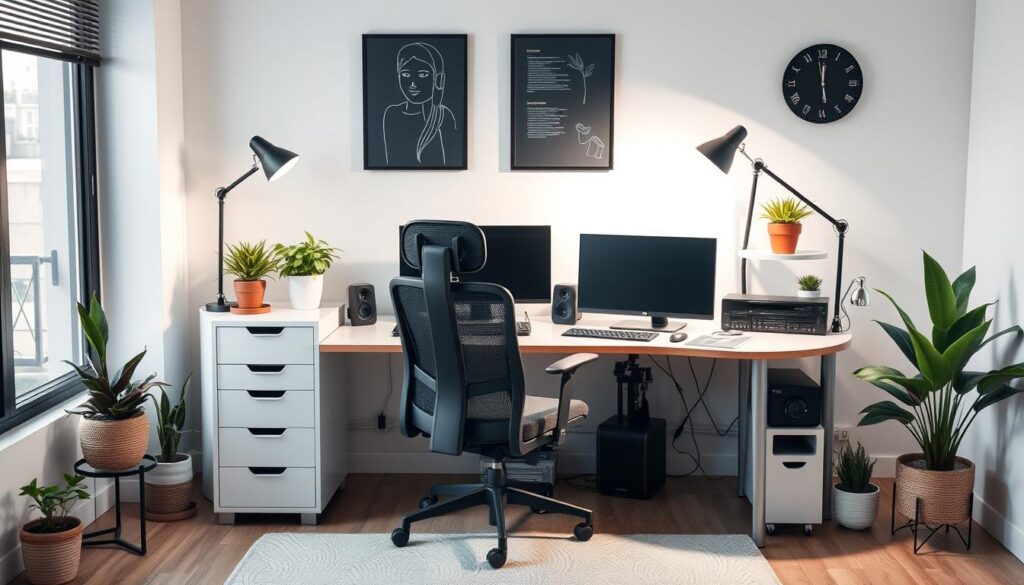
Smart desk orientation is key for an efficient office setup. Your L-shaped desk should fit your workspace perfectly. Right-handed people should place the longer side on the right, while lefties do the opposite.
This setup improves workflow by keeping your main work area close. It makes tasks easier and faster to complete.
Here are important measurements for your L-shaped desk:
- Standard height: 29 to 30 inches
- Longer side length: 60 to 72 inches
- Shorter side length: 48 to 58 inches
For a small home office, try a 60×24-inch main surface with a 42×20-inch return. This combo gives you two layout options: 80×42-inch or 60×66-inch workspace.
Leave about 42 inches of space for your chair to move freely. This ensures comfort and ease of movement.
Natural light is crucial in your office setup. Place your desk to avoid screen glare while getting plenty of daylight. This simple change can make you more productive and happier.
For storage, Laurel Foundry Modern Farmhouse offers stylish options. These blend function with farmhouse charm, adding to your office appeal.
A well-planned workspace layout boosts workflow. Take time to arrange your L-shaped desk and accessories carefully. You’ll create an efficient and comfortable work environment you’ll enjoy.
Storage Solutions and Organization Features
Your L-shaped desk can boost productivity with the right storage features. Let’s explore smart options to maximize your workspace efficiency.
Drawer Configuration Options
Add drawer units for extra desk storage. The IKEA ALEX series offers versatile options. Choose deep drawers for files or shallow ones for office supplies.
Mix and match to create your ideal setup. Some units have wheels, allowing easy movement when needed.
Shelving Integration Methods
Shelves are crucial for good organization. Consider adjustable shelves using shelf pin holes. This lets you customize shelf spacing as your needs change.
Wall-mounted shelves above your desk can free up counter space. They also keep important items within reach.
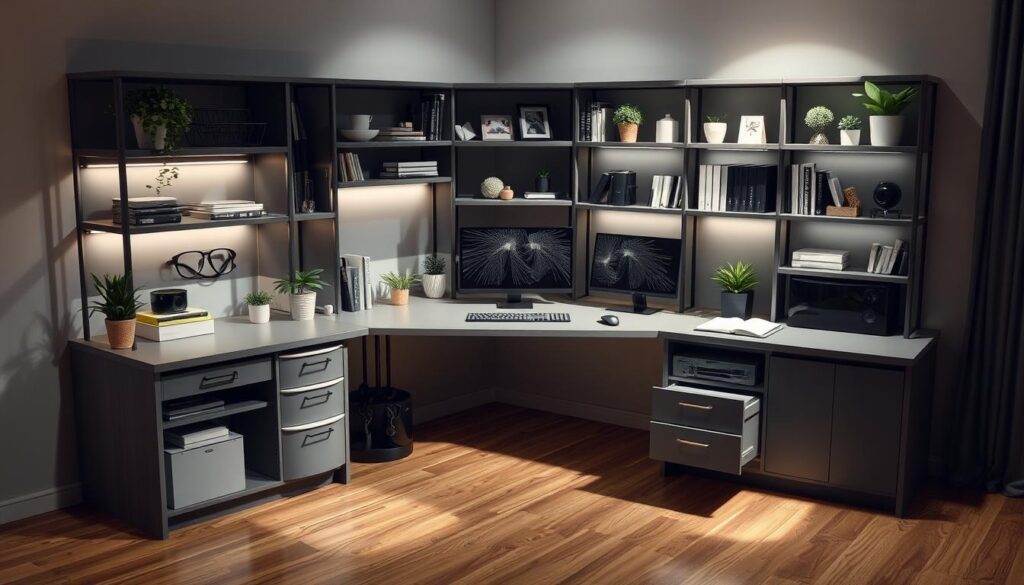
Cable Management Solutions
Tame wire tangles with effective cable management. Use clips, ties, or trays to keep cords organized and hidden.
Some desks have built-in cable ports. You can add your own with a grommet hole saw.
A well-organized desk boosts productivity. Plan your desk storage and organization carefully. Your future self will be grateful!
Ergonomic Considerations for Daily Use
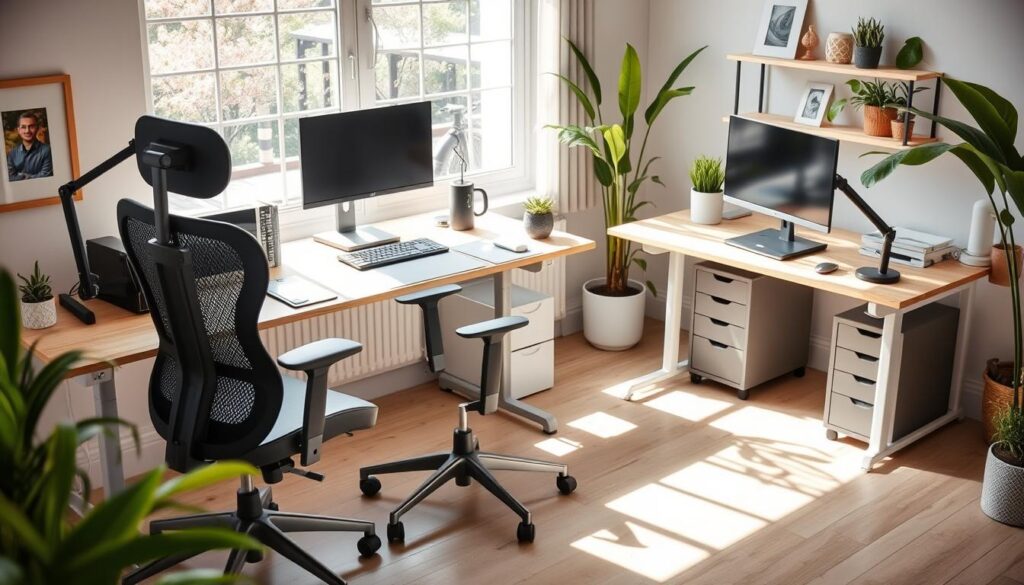
Office ergonomics is key to a comfortable workspace. Your desk height greatly affects your comfort. Standard desks are 28-30 inches tall, suitable for people 5’8″ to 5’10”.
For better health, choose an adjustable desk ranging from 22 to 33 inches high. Standing desks offer more variety, with heights from 36.5 to 47.5 inches.
Some standing desks reach 52 inches, fitting individuals up to 6’8″ tall. These adjustable options encourage movement and can improve productivity.
An ergonomic chair is crucial too. Its seat should be 16 to 21 inches from the floor. This setup allows for:
- Flat feet resting on the floor
- Thighs parallel to the ground
- Arms level with the desk surface
For computer work, set your desk at 28 inches. Keep your monitor at eye level using risers or arms. Place keyboard and mouse at elbow height for good posture.
Good lighting reduces eye strain. A comfortable room temperature helps you focus better. These factors create a workspace that boosts well-being and productivity.
Surface Material Selection Guide
Picking the right desk materials is crucial for your workspace. This guide helps you choose the perfect surface for your L-shaped desk.
Durability Factors
Surface durability is vital for a long-lasting desk. Solid wood like Black Walnut or Maple offers excellent resilience. These materials resist scratches and dents, making them ideal for heavy use.
Wood thickness typically ranges from 1.5″ to 1.75″. This adds to the overall durability of the desk surface.
Maintenance Requirements
Different desk materials need varying levels of care. Wood surfaces may require occasional oiling or polishing. Laminate options are easier to clean but might chip over time.
Laminate comes in gloss, matte, stone finish, or traceless styles. Consider your willingness to maintain your desk when choosing materials.
Cost Comparisons
Compare initial prices with long-term value when looking at cost-effective options. Solid wood desks might cost more upfront, but their durability often makes them worthwhile.
Laminate surfaces offer a budget-friendly alternative without sacrificing style. For a mix of affordability and durability, consider custom-built options that blend different materials.
Your choice impacts more than just your wallet. Sustainable practices add value to your purchase. Balance durability, maintenance, and cost to find your perfect L-shaped desk surface.
Assembly and Installation Tips
Ready to build your L-shaped desk? Let’s explore the DIY process. Your 30′ counter design needs careful planning. With the right approach, you’ll create a sturdy workspace.
Step-by-Step Construction Guide
Start by making nine legs for your desk. Four legs should be 29 ¼” long. The other five should reach 30″ in length.
Next, build the cabinets using ¾” plywood sheets. Drill shelf pin holes for adjustable shelves. Install 16″ drawer slides for the inset drawer in one cabinet.
Common Installation Challenges
Ensuring desk stability can be tricky, especially across 30 feet. Use flat brackets to attach the plywood top to end pieces. Add small corner brackets to each cabinet to keep the top flat.
You might worry about flex in the middle. However, the desk will be surprisingly strong with just a couple of brackets.
Safety Precautions
Put safety first during installation. Use proper tools like circular saws, miter saws, and drill/drivers. Wear protective gear when using power tools.
Follow maker guidelines for hardware installation. Be careful with dowels and wood glue when joining parts. These steps will help you build a safe, functional L-shaped desk.



